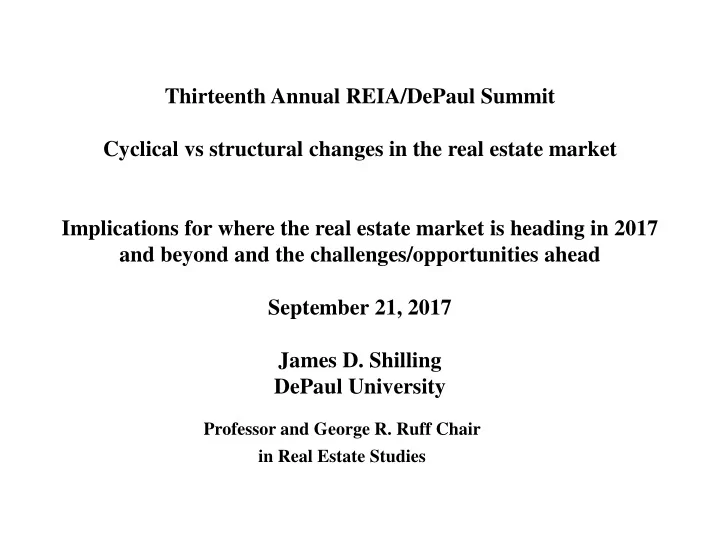

Thirteenth Annual REIA/DePaul Summit Cyclical vs structural changes in the real estate market Implications for where the real estate market is heading in 2017 and beyond and the challenges/opportunities ahead September 21, 2017 James D. Shilling DePaul University Professor and George R. Ruff Chair in Real Estate Studies
Thirteenth Annual REIA/DePaul Summit In the Near Term Higher interest rates could mean trouble for real estate values S&P 500 REIT Index relative to S&P 500 Composite Index 10-year Treasury Yield (Inverted), % Source: Bloomberg, Standard & Poors
Thirteenth Annual REIA/DePaul Summit In the Near Term Low unemployment could contribute to higher interest rates Number of Unemployed as a Percentage of the Labor Force Source: US Bureau of Labor Statistics
Thirteenth Annual REIA/DePaul Summit In the Near Term The homeownership rate could move higher Proportion of Households that is Owner-Occupied, % Source: US Census Bureau
Thirteenth Annual REIA/DePaul Summit In the Near Term Lending standards have been getting tighter Percentage of Banks Tightening Standards for Commercial Real 35 30 Estate Loans, % 25 20 15 10 5 0 2013:Q4 2014:Q1 2014:Q2 2014:Q3 2014:Q4 2015:Q1 2015:Q2 2015:Q3 2015:Q4 2016:Q1 2016:Q2 2016:Q3 2016:Q4 2017:Q1 2017:Q2 -5 -10 -15 Source: Board of Governors, Federal Reserve System
Thirteenth Annual REIA/DePaul Summit Forces Shaping the Outlook in 2017 and Beyond The income inequality challenge: rising income gaps in the US as well as in advanced countries Source: Piketty, Saez, and Zucman (2016)
Thirteenth Annual REIA/DePaul Summit Forces Shaping the Outlook in 2017 and Beyond More upheaval in retail sector is likely Bloomberg REIT Retail Indices S&P Retail Index and Source: Bloomberg, Standard & Poors
Thirteenth Annual REIA/DePaul Summit Four Key Takeaways Global economic growth in 2017 and beyond will slow (mainly due to ageing) and will be increasingly driven by innovation and investment skills. Major shifts in the retail sector will likely continue as the sector “staggers” towards long-term recovery (including a trend toward experiential retail, a shift to “Omni Channel,” a trend toward new fulfillment models and new distribution methods, and the repositioning of a number of centers as retailers shutter physical stores and/or go out of business altogether). Rising income gaps in advanced countries will create a strong demand for “workforce” housing. Investors need to be prepared for a shifting debt market. Bank lending standards have been getting tighter. Most insurance companies have a mechanism that slows down lending as allocations are reached. Such constraints are likely to cause a rise in non-bank lenders.
Recommend
More recommend